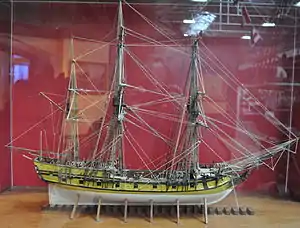 American privateer Rattlesnake (circa 1781) | |
| History | |
|---|---|
| Name | Rattlesnake |
| Namesake | Rattlesnake |
| Builder | John Peck, Plymouth, Massachusetts (probably)[1][2] |
| Launched | 1780[1] |
| Captured | 17 June 1781 |
| Name | HMS Cormorant |
| Namesake | Cormorant |
| Acquired | By capture |
| Renamed | Rattlesnake (1783) |
| Fate | Sold 10 October 1786 |
| General characteristics [2] | |
| Tons burthen | 198+70⁄94 or 200 bm |
| Length |
|
| Beam | 22 ft 4 in (6.8 m) |
| Depth of hold | 8 ft 10+1⁄2 in (2.7 m) |
| Propulsion | Sails |
| Complement |
|
| Armament |
|
HMS Cormorant was probably launched in 1780 at Plymouth, Massachusetts. She was commissioned as the Massachusetts privateer Rattlesnake in 1781. The Royal Navy captured her shortly after she set out on a cruise and purchased her. In November 1781 she carried to England the first news of General Cornwallis's defeat. The Royal Navy registered her under the name Cormorant. In 1783 the navy renamed her Rattlesnake. It paid her off and sold her in 1786.
Privateer Rattlesnake
Rattlesnake was probably drawn by John Peck of Boston, Massachusetts, and probably built at Plymouth in 1780. She was very lightly built and was reputedly very fast. Rattlesnake had the appearance of a miniature frigate, with detached quarterdeck and forecastle.[1]
Rattlesnake was commissioned on 12 June 1781 under Commander Mark Clark (or Clarke).[3] She had barely begun her first cruise when she encountered the 44-gun frigate HMS Assurance, Captain James Cumming.
Assurance captured Rattlesnake on 17 June.[4] He sent her into New York, where she arrived on 8 July. The Royal Navy purchased her on 28 July at Boston.[2]
HMS Rattlesnake
Captain John Melcombe assumed command in September, sailed to England on 29 October, and arrived in late November. Melcombe arrived at the Admiralty on the Sunday evening before 27 November, bearing the news that General Cornwallis had surrendered at Yorktown.[5] (All the reports of Melcombe's arrival refer to him as Captain of His Majesty's sloop Rattlesnake.)
The Navy registered Rattlesnake on 30 November,[2] as HMS Cormorant, there being a Rattlesnake already in service, and Cormorant just having been lost.[lower-alpha 1]
HMS Cormorant
_RMG_J5106.png.webp)
Cormorant underwent fitting at Plymouth between November 1781 and February 1782. On 19 July 1782 Cormorant recaptured Marine.[7] On 2 July Marine, Rendel, master, had put Torbay, having been chased near Plymouth by a French privateer while Marine was sailing from Darmouth to Ireland.[8]
On 30 July Cormorant captured the 10-gun naval cutter Téméraire 8–9 leagues (39–43 km) west south west of Cape Clear. She was armed with ten 6-pounder guns and had a crew of 50 men under the command of lieutenant de fregate LeFer. She was nine days out of Brest and taking dispatches to the combined fleets. Before he struck Le Fer threw overboard the dispatches, her logbook and papers, and eight guns.[9] She then arrived at Cork.[10]
In August 1783 the Navy renamed Cormorant Rattlesnake, and Commander John Melcombe recommissioned her.
HMS Rattlesnake
On 3 November 1783 Rattlesnake sailed for the Mediterranean.[2]
On 10 November 1784, Rattlesnake, Captain Melcombe, was escorting the merchantman Countess of Tuscany to Gibraltar when they encountered an Algerine naval squadron of nine ships under the command of an admiral. The Algerine admiral pretended to believe that Rattlesnake was not a British warship and compelled both vessels to put into Algiers. There the Dey of Algiers detained them for five days before releasing them, without apology.[11]
On 29 November 1785 Commander Thomas Hamilton replaced Melcome.
Fate
In July 1786, Rattlesnake was paid off. She was sold on 10 October.[2]
Notes
Citations
- 1 2 3 Chapelle (1935), pp. 134 & 132.
- 1 2 3 4 5 6 Winfield (2007), p. 291.
- 1 2 3 http://www.awiatsea.com/Privateers/R/Rattlesnake%20Massachusetts%20Ship%20[Clark].html#B000003T American War of Independence at Sea: Rattlesnake Massachusetts Ship (Clark).
- ↑ "No. 12227". The London Gazette. 22 September 1781. p. 1.
- ↑ New Jersey Archives... (1977), 2nd Series, Vol. 5, pp.393-4.
- ↑ Lloyd's List №1333.
- ↑ "No. 12408". The London Gazette. 21 January 1783. p. 3.
- ↑ Lloyd's List №1377.
- ↑ "No. 12322". The London Gazette. 13 August 1782. p. 1.
- ↑ Lloyd's List №1386.
- ↑ Playfair (1888), pp. 266–7.
References
- Chapelle, Howard Irving (1935). The History of American Sailing Ships. Bonanza Books.
- New Jersey Archives: Documents Relating to the Revolutionary History of the State of New Jersey (1977) Series 2, Vol.5 (AMS Press; New Jersey Historical Society)
- Playfair, Sir Robert Lambert (1888). A Bibliography of Algeria: From the Expedition of Charles V in 1541 to 1887. J. Murray.
- Winfield, Rif (2007). British Warships in the Age of Sail 1714–1792: Design, Construction, Careers and Fates. Seaforth. ISBN 978-1844157006.
External links
 Media related to HMS Cormorant (ship, 1781) at Wikimedia Commons
Media related to HMS Cormorant (ship, 1781) at Wikimedia Commons